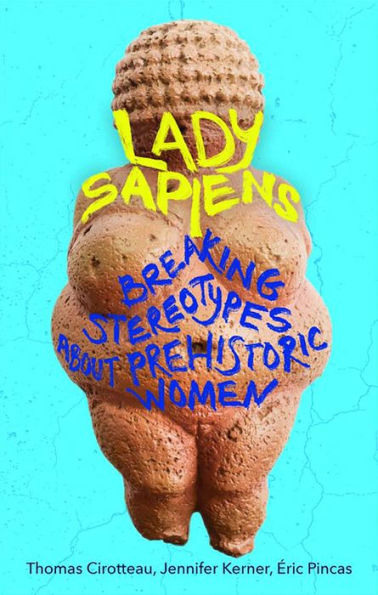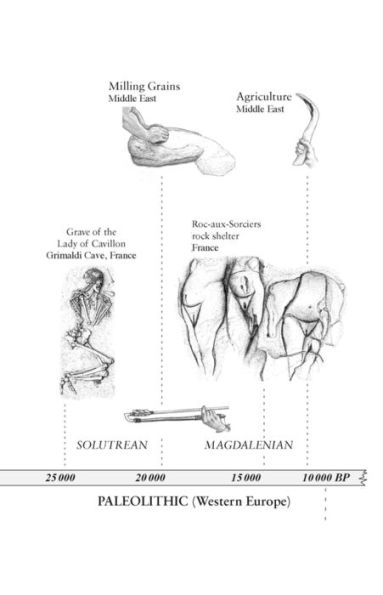Read an Excerpt
chapter 1
T H ErE T UrN OfL A DY S A P I E N S
On 11 July 2019 at 4:30 p.m., a prehistoric figurine emerged
from the sands of Picardy – it was female, six centimetres
tall, and it was the first such discovery in France for over sixty
years. The Venus of Renancourt – as she was baptized – had
come to light, evoking a distant echo of every woman in pre-
history. Among the scientific community, emotions ran high,
and even the general public appreciated the magnitude of the
find. Catherine Schwab, Conservator of Cultural Heritage
at the Musée d’Archéologie Nationale in Saint-Germain-
en-Laye, finds the magnetic attraction that the object exerts
astonishing: ‘These images speak to us, move us, challenge
us. It is fascinating to see that these objects haven’t lost their
power over so many millennia.’
This discovery is intriguing. Who were prehistoric women?
Did they really look like this figurine? What were their role,
their activities and their status within tribes? Did they exist
simply to reproduce, or were they great mythical fertility
figures? Were they subordinate members of the group or
actual providers of food, essential to the survival of their
tribe? Could they have been leaders, priestesses or goddesses?
These are the many questions that encourage us to unravel
the mysteries of prehistoric femininity. The exceptional dis-
covery of the Venus of Renancourt is the start of our journey
chapter 1
T H ErE T UrN OfL A DY S A P I E N S
On 11 July 2019 at 4:30 p.m., a prehistoric figurine emerged
from the sands of Picardy – it was female, six centimetres
tall, and it was the first such discovery in France for over sixty
years. The Venus of Renancourt – as she was baptized – had
come to light, evoking a distant echo of every woman in pre-
history. Among the scientific community, emotions ran high,
and even the general public appreciated the magnitude of the
find. Catherine Schwab, Conservator of Cultural Heritage
at the Musée d’Archéologie Nationale in Saint-Germain-
en-Laye, finds the magnetic attraction that the object exerts
astonishing: ‘These images speak to us, move us, challenge
us. It is fascinating to see that these objects haven’t lost their
power over so many millennia.’
This discovery is intriguing. Who were prehistoric women?
Did they really look like this figurine? What were their role,
their activities and their status within tribes? Did they exist
simply to reproduce, or were they great mythical fertility
figures? Were they subordinate members of the group or
actual providers of food, essential to the survival of their
tribe? Could they have been leaders, priestesses or goddesses?
These are the many questions that encourage us to unravel
the mysteries of prehistoric femininity. The exceptional dis-
covery of the Venus of Renancourt is the start of our journey
Gradually, we uncovered the remains that had been aban-
doned by prehistoric people when they left. The surface
occupation site had been quickly covered by a layer of
silt blown in by the wind, which meant that the site was
perfectly fossilized.
And so with each stroke of the archaeologist’s brush, the
ice-age landscape was revealed. The Renancourt site had
been occupied by prehistoric hunter-foragers:*these nomads
moved with the seasons, following large herds of horses,
deer or reindeer. They hunted, fished, foraged for shellfish
and gathered plants for food and to use as medicine. The
Renancourt humans lived in a period we call the Gravettian,
which is dated between 28,000 and 22,000 years ago in Europe,
between the Atlantic seaboard and Western Russia.
In Renancourt, one of these human groups founded a set-
tlement on a hillside in a dry valley, facing a beige chalk cliff.
A highly strategic position, this valley creates bottlenecks in
certain places, which enabled hunters to trap their prey. Hunting
was carried out using long wooden shafts armed at their ends
with a powerful point made of stone or bone to create a spear.
They were thrown directly by hand or using an elongated
rod with a hook at the end, which extended the hunter’s arm
and which, by means of a flexible wrist movement, increased
the speed and penetration of the throw. These devices, called
spear throwers, were decorated with delicate, figurative motifs.
Humans thus associated the art of hunting with art itself.
The large quantity of horse bones found at the Renancourt
site also provide evidence supporting the hypothesis that these
were good hunting grounds. To see what the prehistoric horses
eaten by humans looked like, we can refer to the images found
in the Cave of Niaux in the Ariègedépartement. They bear an
astonishing resemblance to the magnificent Przewalski’s horse,
a small animal that can be found today on the Mongolian
steppe. They are stockily built, with a large head on a short
neck, their coat generally a tan colour, fading to a sandy beige
and ending with touches of black on all the extremities (lower
legs, tail and muzzle). Of course, horses with other kinds of
coats already existed in the Upper Paleolithic, with British
geneticists revealing that dappled coats – that is, with darker
spots on a grey background – already existed in the case of
some types of horse. Moreover, this particular kind of coat
was depicted on the walls of the Pech Merle Cave in the Lot
département, where artists also created hand prints.
The Renancourt encampment was not just perfect for hunting
horses, it was also an ideal location for the easy supply of raw
materials. Flint and chalk, used in the creation of lots of dif-
ferent tools, are plentiful near the site. Ideal for creating sharp
tools, flint was used to cut meat and work on the hides used to
make clothes, but it was also employed to fashion objects less
essential to survival. Unexpected treasures have been discovered
in this time capsule, testifying to a sophisticated culture.
It all started in July 2014, when Clément Paris and his team
unearthed the first blocks of chalk. He didn’t yet know that he
had just excavated some real archaeological gems. The first of
these beautiful naked figurines was indeed about to reveal itself...
It was the third day of excavations... The first Venus looked
like a shapeless lump of chalk... We decided to extract the
block of sediment, and it was during our detailed examina-
tion in the laboratory that this figurine appeared before
our very eyes... To this day it’s the largest figurine that’s
been found in the settlement – it’s twelve centimetres tall.
We didn’t expect to find this!
Over five years, Clément Paris and his team unearthed about
fifteen more or less complete or broken Venuses. All bear the
marks of having been worked and fashioned. But the highlight
of the discoveries came in July 2019.
The team discovered the piece that would become the
icon of the site: the Venus of Renancourt, a six-centimetre
figurine, delicately sculpted in chalk, with anatomical details
such as prominent breasts and plump buttocks, completely
in accordance with the appearance of figurines from this
period dating from 27,000 years ago.
Each Venus of Renancourt has a unique morphology. The
most famous of them wears a small checked cap that she
seems to have borrowed from Austria’s Venus of Willendorf
or France’s Venus of Brassempouy (see p. 17). The backside of
the very first figurine unearthed in Renancourt is so generous
that it seems like a pedestal supporting the young woman,
whose upper body is frail and elegant. In the case of all the
figurines, ‘the female attributes had been emphasized by
the artist. Magnificent breasts are accentuated, with exag-
gerated buttocks extending backwards,’ says Clément Paris,
gesturing voluptuously.
To complete the series, isolated fragments make up a few
body parts that have been completely dismembered: a plump
belly with the navel clearly visible or a pubic triangle clearly
marked between two generous thighs. The lucky man who
discovered these priceless remains proudly highlights the
magnitude of this find:
These Venus figurines are iconic objects in prehistory, but
they had been unknown to the whole of north-western
Europe, until we discovered them... And thanks to this
exceptional site, we have doubled the number of Gravettian
Venuses found in France.
But that’s not all. The presence of lots of fragments found
in a small space suggests that Renancourt was undoubtedly
an artists’ workshop – a rare piece of evidence.
The first thing that gave us the idea of a manufacturing
workshop was the number of figurines... Fifteen Venus frag-
ments, that’s a lot! The second set of clues is the discovery
of amorphous chalk fragments that bear the trace of tools.
This is waste produced during manufacture, falling from
the block as the Venus is created. Finally, we managed to
determine that the chalk comes from the cliffs located in
the immediate vicinity of the site.
So the Amiens site produced solid evidence to support the
workshop hypothesis, namely several half-finished Venus
figurines and others abandoned as a result of accidental
breakage. Archaeologists also observed tool marks on the
surface of the soft chalk: the fact that these waste fragments
were saved suggests a piece of unfinished work. Thanks to
up-to-date analytical methods, the gestures and tools used by
our ancestors to give birth to the Venus of Renancourt will
soon come under expert microscopic examination and reveal
all their secrets. The photographs, meanwhile, have already
told their story. By skilfully applying filters to the digital
images, scientists have detected traces of red pigments on
one fragment. Clément Paris is thrilled by such a discovery:
‘One of the statuettes was painted on the bust using ochre...
This specimen has been extremely well preserved, even after
23,000 years in the ground.’
The presence of ochre on prehistoric Venuses has been
found on other figurines, such as those discovered at
Kostenki in Russia, Willendorf in Austria, Dolní Věstonice
in the Czech Republic and Laugerie-Basse in the Dordogne,
where the very first figurine, called theVenus impudica,
was discovered in 1884 (see p. 17). The presence of this
mineral dye may have served several functions. The first is
obviously to add colour to figurines made of monochrome
materials. Ochre was deployed extensively to this end
on the walls of prehistoric caves: it is therefore possible
that it was also used to create patterns on the sculptures.
However, we might consider another function. Ochre is an
abrasive material which can therefore smooth the surface
of an object. Either way, the presence of this dye proves
that we are dealing with works of art that have been given
a particular kind of finish.
Other sophisticated examples have been excavated at the
site. While the artists of the time were more likely to represent
women naked, Clément Paris discovered that the Renancourt
artists also knew how to fashion delicate personal ornaments:
‘We were incredibly lucky to discover some decorative pieces.
Some are made from pieces of fossil, in particular turritella
fossils.’
Turritellas are pretty, corkscrew-shaped fossilized sea-
shells which were collected painstakingly and possibly sewn
onto clothing. Clément Paris does not accept the hypothesis
that they were made into necklaces or bracelets, because
they do not bear the characteristic signs of wear or friction.
He points out that these fossils came from a distant quarry
at least 100 kilometres to the south. Taking such an amount
of time to find them suggests that personal ornamentation
was a serious concern for our ancestors. These delicate
decorative pieces attest beyond doubt to the sophistication
of these ancient humans’ personal ornaments. Their jewel-
lery box also contained other decorative elements: at
Renancourt, Clément Paris discovered ‘chalk discs painted
with ochre and made directly on site in the same way as
the figurines’.
















